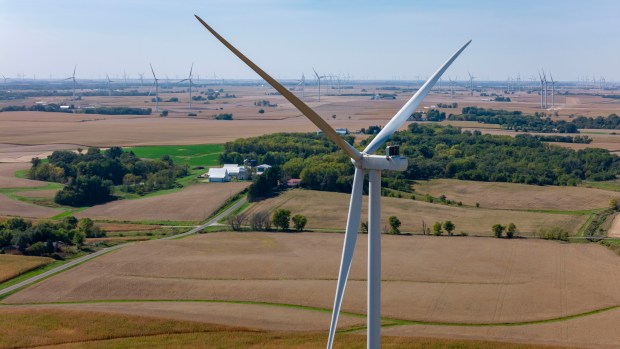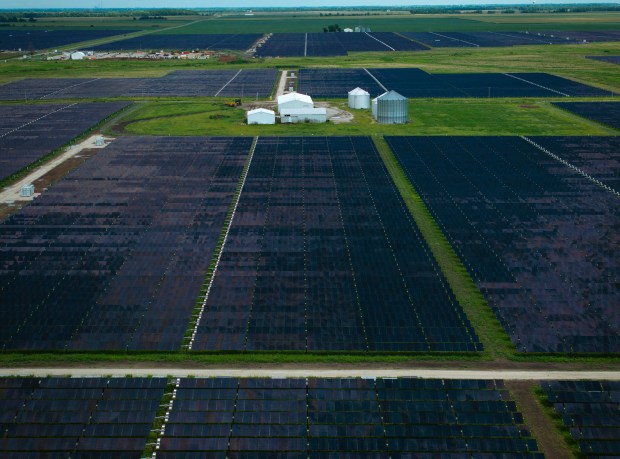In its quest to get a million electric vehicles on the road by 2030, Illinois was counting on $148 million in federal funding to help build a statewide network of public EV chargers.
Now that funding has been frozen — and targeted for possible reduction or elimination — under a wide-ranging executive order that President Donald Trump signed on his first day in office.
Also in limbo: another federal program that was to provide Illinois with millions of dollars for public EV chargers.
“I’m very nervous right now that (the Trump executive order) is going to limit Illinois’ ability to achieve its EV future,” said Brian Urbaszewski, environmental health programs director at the Chicago-based Respiratory Health Association.
If the federal funding drops or disappears, “it really puts that (1 million EV) goal that we have in Illinois in jeopardy,” he said.
EVs and their chargers appear to be a prime target of Trump’s “Unleashing American Energy” executive order, but they are by no means the only Illinois clean energy projects that could be in for a bumpy ride as the president takes bold steps to reverse the ambitious clean energy policies of his predecessor.
The executive order pauses funds coming from President Joe Biden’s signature climate law, the Inflation Reduction Act, including incentives for solar and wind projects and a federal tax credit of up to $7,500 for EV buyers.
The executive order also targets the opportunity for states to adopt California-style vehicle emissions rules that exceed national standards, an approach that Illinois is currently considering.
The executive order sets up a 90-day review period for clean energy projects funded under the Inflation Reduction Act and the 2021 Bipartisan Infrastructure Law, after which agency heads will submit recommendations.
Illinois experts and advocates noted that there are still a lot of unknowns. Environmental Law and Policy Center Chief Executive Officer Howard Learner said Trump’s power is limited in areas such as solar energy tax credits and EV tax credits, which were voted into law by Congress.
“No president in an executive order can willy-nilly overturn congressional legislation,” Learner said.
The president can go to Congress with his preferred policies and ask for changes, Learner said, but solar energy tax credits and wind production tax credits already have strong bipartisan support.
Funds for the Illinois EV charger network under the National Electric Vehicle Infrastructure Formula Program, on the other hand, are subject to more direct presidential control.
“Here the administration does have a degree of flexibility, and can decide, with regard to new expenditures, whether to move forward or not,” Learner said. “If (the expenditures) have been congressionally authorized and appropriated, the administration has to follow what Congress has decided.”
Of the $148 million in money for an electric charger network that Illinois was expecting from the EV formula program, the state announced $25 million in grants in September for 37 projects with 182 new charging ports. Applications are currently open for a second round of funding, expected to distribute about $24 million in grants.
It’s unclear how much of the money could be vulnerable under the Trump executive order, but Urbaszewski said the state has to first spend its own money and then get reimbursed by the EV formula program or the federal Charging and Fueling Infrastructure Grant Program.
That reimbursement system means money stays in federal hands longer, which could be a disadvantage if funding is cut off.
“That, and the fact that those two programs are specifically called out in the executive order — specifically — makes me a little nervous,” Urbaszewski said.
Asked about the effects of Trump’s executive order on Illinois, the Illinois Environmental Protection Agency issued a written statement saying, “At this time, IEPA is not aware of any impacts to grants and will be monitoring the situation closely.”
At the Union of Concerned Scientists, Midwest Policy Director James Gignac highlighted another issue for Illinois: the Inflation Reduction Act’s solar and wind incentives.
“There’s a lot of development that’s underway, based in part on those incentives. If they were to be eliminated, reversed or taken away, that could have an effect for sure on this area,” he said.
The executive order is not expected to have much impact on residential solar in Illinois, according to Illinois Solar Energy & Storage Association Executive Director Lesley McCain. The federal government currently offers a tax credit worth up to 30% of the cost to install a solar roof.
“The executive order does not impact (that tax credit), as it is part of the federal tax code, but we will keep a close eye on further developments,” McCain said in a written statement.
Urbaszewski, who supports a bid to adopt the California-style clean car and clean truck rules in Illinois, said those rules could help Illinois meet its EV goals if federal EV-charger funding were cut.
The rules, currently under consideration by the Illinois Pollution Control Board, would require that all new passenger vehicles sold in Illinois be zero emissions by 2035.
During his first term, Trump tried to rescind a waiver that allowed California to pursue car emissions standards stricter than the federal government’s.
“This is all going to end up in court, and it’s going to take years to figure out whether the U.S. EPA under Trump actually has the authority to take back a waiver once it has been granted,” Urbaszewski said.
In the meantime, he’d like to see Illinois adopt the California standards, which he said would accomplish the EV formula program goal of expanding the Illinois charging network.
“If there’s a lot of (electric) cars that show up, businesses are going to smell opportunity, and they’re going to build chargers,” he said.

The Inflation Reduction Act has spurred economic growth in both blue states and red states, and Learner said that solar energy tax credits and wind power production tax credits have strong support on both sides of the aisle.
Since the Inflation Reduction Act, companies have announced 751 new clean energy projects in the U.S., including battery manufacturing sites, new or expanded electric vehicle manufacturing facilities, and solar and wind manufacturing plants, according to a recent report from Climate Power, a strategic communications organization.
More than half of those projects are in congressional districts represented by Republicans in the House of Representatives.
Learner sees a parallel between the Biden climate plan and another high-profile piece of Democratic legislation: the Affordable Care Act, or Obamacare.
During his first term, Trump vowed to repeal Obamacare, but the program developed bipartisan support as a wide range of Americans started to experience its benefits.
“Today, Obamacare is in place,” said Learner. “There have been some ways in which it’s been cut back or changed by the first Trump administration, and by some of the Supreme Court decisions, but by and large, (24) million Americans are now covered by Obamacare and the program has been successfully implemented.”




